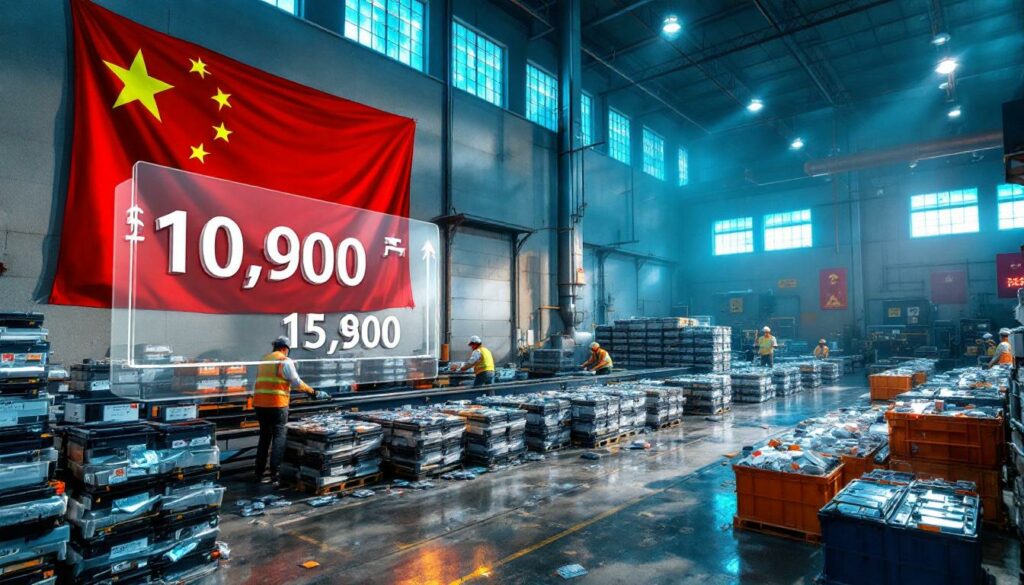What's Happening in the Scrap Battery Market?
The scrap battery market continues to experience tight supply conditions with remarkably stable pricing despite ongoing constraints. According to the latest Shanghai Metal Market (SMM) report from July 11, 2025, recyclers across China have indicated minimal fluctuation in purchasing prices, with the mainstream procurement rate for waste e-bike lead-acid batteries holding steady between 10,000-10,800 yuan per metric ton (tax excluded).
This price stability persists despite the supply squeeze, primarily because of broader market forces affecting the entire lead value chain. As one industry analyst noted, "The current lead price environment lacks sufficient upward momentum to justify procurement price increases, creating a stalemate between tight supply and stable pricing."
Secondary lead smelters throughout the country report inventory levels hovering around average, but these stocks are only sufficient to maintain reduced operational capacity. This inventory constraint has created a self-reinforcing cycle: limited raw materials restrict production output, while stable lead prices prevent smelters from aggressively raising procurement prices to attract more scrap supply.
Market Insight: The disconnect between supply tightness and price stability demonstrates the complex balancing act in recycled metal markets, where downstream product pricing often dictates upstream procurement strategies regardless of supply conditions.
Current Pricing for Waste Lead-Acid Batteries
The pricing dynamics in the waste lead-acid battery sector reveal several important patterns:
- E-bike batteries dominate the recyclable lead-acid battery market in China, with procurement prices holding in the 10,000-10,800 yuan/mt range (tax excluded)
- Regional variations exist but remain minimal, with eastern facilities typically paying at the higher end of the range
- Tax considerations significantly impact actual transaction values, with all reported prices explicitly noted as tax-excluded figures
- Historical comparison shows remarkably stable pricing despite ongoing supply constraints
Industry experts have noted that this price stability during supply constraints is somewhat unusual in commodity markets, highlighting the unique dynamics of the secondary lead industry where production capacity limitations and downstream price pressures create countervailing forces.
Why Is Secondary Crude Lead Supply Remaining Tight?
The scarcity of domestically produced secondary crude lead has emerged as a persistent challenge across China's metals recycling sector. SMM's latest market intelligence reveals a complex patchwork of regional production issues that collectively contribute to nationwide supply tightness.
As of July 11, 2025, the mainstream price for secondary crude lead stands at approximately 15,950 yuan per metric ton (tax excluded), reflecting the premium commanded by this increasingly scarce intermediate material. This pricing reflects not just supply constraints but also the crucial position secondary crude lead occupies in the recycling value chain.
The production landscape across China shows distinctive regional patterns:
| Region | Current Status | Primary Constraint | Production Level |
|---|---|---|---|
| Central China | Non-operational | Equipment failures requiring extended maintenance | 0% of capacity |
| Northern China | Production halted (early July) | Raw material procurement challenges | 0% of capacity |
| Eastern China | Operational but constrained | Limited production capacity despite being sole supplier | Reduced capacity |
Regional Production Challenges
Central China's secondary crude lead refineries remain offline following what was initially planned as routine maintenance. According to SMM, these facilities encountered significant equipment failures during inspection, necessitating extended downtime with no clear resumption timeline. The technical complexity of these repairs has exacerbated the supply shortage from a traditionally important production hub.
Northern China operations face a different but equally challenging obstacle. Since early July 2025, refineries across the region have halted production entirely due to raw material procurement issues. Industry analysts point to a combination of:
- Transport disruptions affecting scrap battery collection networks
- Increased competition for limited scrap resources
- Regulatory compliance challenges in waste material handling
- Cash flow constraints limiting procurement capabilities
Eastern China has consequently emerged as the primary supplier of secondary crude lead nationwide. However, even these operational facilities face significant constraints, with production capacity unable to compensate for the shortfall from other regions. Their firm price quotations reflect both this supply leverage and the higher operational costs associated with maintaining production amid challenging market conditions.
Supply Chain Impact: "The concentration of production in eastern facilities creates logistical inefficiencies for buyers in central and western regions, adding transport costs to already elevated material prices," notes an SMM market analyst.
How Are Supply Constraints Affecting the Secondary Lead Industry?
The persistent supply tightness in both scrap batteries and secondary crude lead is reverberating throughout China's secondary lead industry, creating a cascade of operational challenges and market adjustments. The impact extends far beyond simple price effects, fundamentally altering how facilities operate and strategize.
Impact on Smelter Operations
Secondary lead smelters across China have been forced to adapt their operational models in response to raw material constraints. Key operational changes include:
- Reduced production capacity utilization – Most facilities are operating well below optimal capacity, with many running at just 60-70% of their technical capabilities according to industry estimates
- Modified production scheduling – Smelters have shifted from continuous operations to batch processing to accommodate irregular raw material deliveries
- Inventory management adjustments – Facilities have revised minimum inventory thresholds, accepting lower safety stocks to maintain even limited production
- Procurement strategy adaptations – Despite supply constraints, smelters remain unable to significantly raise purchase prices due to downstream lead price pressures
The operational impact varies significantly by facility size and technical sophistication. Larger, more modern smelters with greater operational flexibility have proven more resilient, while smaller operations face greater challenges in maintaining consistent production levels with limited and irregular raw material supplies.
Market Response to Supply Challenges
The market has developed several distinctive patterns in response to these ongoing constraints:
- Geographic price premiums have emerged, with material in central and western regions commanding higher prices due to transport costs from eastern production centers
- Contract restructuring with both suppliers and customers to accommodate supply uncertainties and production limitations
- Quality specification adjustments as some facilities accept lower-grade inputs to maintain minimal production levels
- Increased interest in alternative lead sources, including potential imports, though regulatory barriers remain significant
"The market is in a holding pattern," explains an industry analyst. "Without sufficient upward momentum in refined lead prices, smelters cannot afford to raise procurement prices enough to stimulate significantly increased scrap collection, yet supply remains tight enough to prevent any price declines."
This dynamic has created a relatively stable pricing environment despite underlying supply challenges, with most market participants adapting operations rather than competing through price adjustments.
What Factors Are Influencing the Current Market Conditions?
The current state of China's scrap battery and secondary crude lead markets reflects a complex interplay of technical, economic, and operational factors. Understanding these interconnected influences provides crucial context for the market's seemingly contradictory combination of tight supply and stable pricing.
Supply-Side Factors
Several critical factors are constraining supply across the recycling value chain:
- Equipment reliability issues in central China have extended beyond routine maintenance timeframes, with specialized replacement parts facing extended lead times
- Raw material collection networks in northern regions are experiencing disruptions that limit the flow of scrap batteries to refineries
- Production capacity limitations in eastern facilities cannot be quickly expanded to compensate for shortfalls elsewhere
- Technical processing constraints mean that even operational facilities cannot simply increase throughput without risking quality issues or equipment damage
These supply constraints have proven remarkably persistent, with limited signs of near-term resolution. The specialized nature of secondary lead refining equipment means that maintenance issues cannot be quickly addressed, while raw material procurement challenges reflect broader systemic issues in China's waste management and recycling infrastructure.
Pricing Influences
Despite tight supply, pricing remains surprisingly stable due to countervailing forces:
- Downstream lead price stability creates a price ceiling for secondary materials, as refiners cannot pass higher input costs to their customers
- Operating cost pressures from energy, labor, and environmental compliance create a price floor below which facilities cannot profitably operate
- Regional production imbalances create geographic price disparities that complicate nationwide pricing analysis
- Market expectations remain cautious, with few participants anticipating significant near-term changes in the broader lead market
Market Insight: "The secondary lead sector operates in a unique pricing environment where traditional supply-demand dynamics are heavily modified by downstream price constraints, creating unusual stability despite clear supply tightness," notes an SMM industry analyst.
A key factor often overlooked is the impact of environmental regulatory compliance on both operations and pricing. Facilities must maintain strict emissions standards regardless of production levels, creating fixed compliance costs that become proportionally higher at reduced operating rates. This regulatory burden further complicates the economic calculations for smelters considering production adjustments.
Operational Constraints
Beyond supply and pricing factors, several operational realities shape current market conditions:
- Technical efficiency thresholds mean many processes become uneconomical below certain capacity utilization rates
- Workforce management challenges as facilities struggle to maintain skilled technical teams during reduced operations
- Cash flow pressures from reduced output combined with relatively stable fixed costs
- Strategic inventory decisions balancing production needs against cash preservation
These operational factors have created a market environment where participants across the value chain are maintaining a holding pattern – adapting to constraints rather than attempting to fundamentally alter market dynamics through aggressive pricing or procurement strategies.
FAQ About the Scrap Battery and Secondary Lead Markets
What is the current price range for waste e-bike lead-acid batteries?
The mainstream procurement price for waste e-bike lead-acid batteries currently ranges from 10,000 to 10,800 yuan per metric ton (excluding tax). This pricing has remained relatively stable despite ongoing supply constraints, primarily due to limited upward momentum in downstream lead prices that prevents recyclers from significantly raising procurement rates.
Which regions are currently producing secondary crude lead?
Eastern China has emerged as the primary supplier of domestically produced secondary crude lead as of July 2025. Central China's facilities remain offline following extended maintenance shutdowns due to equipment failures, while northern China's refineries halted production in early July due to raw material procurement challenges. This regional production imbalance has created logistical challenges for buyers in other parts of the country.
What is causing the tight supply of secondary crude lead?
The supply constraints stem from several interconnected factors:
- Technical failures requiring extended maintenance at central China refineries
- Raw material shortages affecting northern China's production capabilities
- Limited production capacity even among operational facilities in eastern China
- Logistical challenges in redistributing available materials across regions
These factors collectively create a persistent supply tightness that shows limited signs of near-term resolution.
What is the current price for secondary crude lead?
As of July 11, 2025, the mainstream price for secondary crude lead stands at approximately 15,950 yuan per metric ton (excluding tax), according to SMM data. This pricing reflects both the material's scarcity and its essential position in the secondary lead value chain, though pricing remains constrained by broader lead market dynamics.
How are smelters adapting to current market conditions?
Secondary lead smelters are implementing several adaptation strategies:
- Operating at reduced capacity to match available raw material supply
- Maintaining minimum inventory levels sufficient only for limited operations
- Exploring alternative material sourcing options where technically feasible
- Adjusting maintenance schedules to coincide with periods of lowest material availability
- Optimizing production processes for efficiency at lower operating rates
These adaptations allow facilities to maintain some level of production while navigating the challenging supply environment.
Market Outlook for Secondary Lead Production
The secondary lead market faces a challenging near-term outlook with persistent supply constraints likely to continue through at least the third quarter of 2025. The regional production imbalance – with eastern China serving as the primary supplier – appears structurally entrenched until technical and raw material issues are resolved in other regions.
Several key factors will determine how market conditions evolve in coming months:
- Maintenance resolution timeline for central China facilities will significantly impact overall domestic supply
- Raw material procurement improvements in northern regions could rapidly restore production capacity
- Production capacity adjustments among eastern facilities may occur if market incentives change
- Lead price movements on both domestic and international markets will influence procurement strategies
Disclaimer: The following analysis represents current market assessment based on available information. Actual conditions may evolve differently based on unforeseen developments in technical, economic, or regulatory factors.
Key Factors to Monitor
Industry participants should closely track several indicators that may signal changing market dynamics:
- Equipment repair progress at central China facilities, particularly specialized component deliveries
- Scrap collection volumes in northern regions as an early indicator of improving raw material availability
- Capacity utilization rates among eastern producers for signs of production adjustments
- Lead price movements on the Shanghai Futures Exchange (SHFE) that could alter procurement economics
- Regulatory developments that might impact either production costs or material handling requirements
The interrelationship between these factors creates a complex forecasting environment. For example, even modest increases in lead prices could enable higher procurement prices for scrap batteries, potentially stimulating increased collection rates and easing raw material constraints – but this would only translate to increased production if technical issues at refineries are also resolved.
Regional Recovery Prospects
The outlook for regional production recovery varies significantly:
- Eastern China will likely maintain its position as the primary production hub in the near term, with facilities operating at capacity levels dictated by raw material availability and economic factors
- Central China faces uncertain recovery timing dependent on equipment repair timelines, with phased resumption likely as individual facilities resolve their specific technical challenges
- Northern China may see faster recovery if raw material procurement issues are resolved, as these facilities generally face fewer technical constraints than their central region counterparts
The geographic redistribution of production capacity has significant implications for the industry's overall efficiency and cost structure. The concentration of production in eastern facilities creates logistical challenges for material movement that add costs throughout the value chain, particularly for end-users in central and western regions.
Industry stakeholders should prepare for continued supply challenges while monitoring these key indicators for early signs of market evolution. The current equilibrium – characterized by tight supply but stable pricing – appears likely to persist in the near term, requiring continued operational adaptation rather than anticipating rapid market normalization.
The closed-loop battery recycling efforts being pioneered by major manufacturers could eventually help address some of these supply challenges, though implementation timelines extend beyond the current market disruption. Furthermore, the ongoing mining industry evolution will continue to shape both primary and secondary metal markets as extraction technologies and sustainability requirements evolve.
Companies across the value chain are increasingly exploring sustainable mining transformation strategies that could eventually reduce dependence on secondary materials, though current market conditions underscore the importance of developing more robust sustainable battery recycling ecosystems. Finally, the current regional production imbalances may accelerate industry consolidation insights as operators seek scale and stability through strategic partnerships in a challenging market environment.
Looking to Capitalise on the Next Mining Market Opportunity?
Stay ahead of the curve with real-time alerts on significant ASX mineral discoveries through Discovery Alert's proprietary Discovery IQ model, which transforms complex market data into actionable investment insights. Explore historic examples of exceptional market returns from major discoveries by visiting Discovery Alert's dedicated discoveries page and position yourself to act quickly when the next opportunity emerges.




